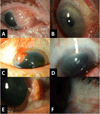Diagnosis and Medical Management of Ocular Surface Squamous Neoplasia
- PMID: 28184236
- PMCID: PMC5293314
- DOI: 10.1080/17469899.2017.1263567
Diagnosis and Medical Management of Ocular Surface Squamous Neoplasia
Abstract
Introduction: Topical chemotherapy has gained popularity among clinicians for the treatment of ocular surface squamous neoplasia (OSSN). The principal topical chemotherapy agents used in the management of OSSN are interferon-α2b, 5-fluorouracil, and mitomycin C. High-resolution optical coherence tomography (HR-OCT) is a non-invasive technique that can differentiate OSSN from other ocular surface lesions.
Areas covered: This review highlights the current regimens and diagnostic modalities used in managing OSSN. A review of the literature was performed using the keywords "conjunctival intraepithelial neoplasia", "ocular surface squamous neoplasia", "optical coherence tomography", "interferon-α2b", "5-fluorouracil" and "mitomycin C".
Expert commentary: Topical chemotherapy for OSSN can be used as primary therapy, for chemoreduction prior to surgical excision, and postoperatively to prevent tumor recurrence. It has the advantage of treating microscopic disease as well as large tumors. HR-OCT provides an "optical biopsy" that can assist in diagnosis and guide management of OSSN lesions.
Keywords: 5-fluorouracil; conjunctival neoplasia; high resolution optical coherence tomography; interferon-α2b; mitomycin C; ocular surface squamous neoplasia; topical chemotherapy.
Conflict of interest statement
Declaration of interest The authors have no relevant affiliations or financial involvement with any organization or entity with a financial interest in or financial conflict with the subject matter or materials discussed in the manuscript.
Figures



References
-
- Lee GA, Hirst LW. Ocular surface squamous neoplasia. Survey of Ophthalmology. 1995;39(6):429–450. - PubMed
-
- Basti S, Macsai MS. Ocular surface squamous neoplasia: a review. Cornea. 2003;22(7):687–704. - PubMed
-
- Shields CL, Demirci H, Karatza E, Shields JA. Clinical survey of 1643 melanocytic and nonmelanocytic conjunctival tumors. Ophthalmology. 2004;111(9):1747–1754. - PubMed
-
- Steffen J, Rice J, Lecuona K, Carrara H. Identification of ocular surface squamous neoplasia by in vivo staining with methylene blue. Br J Ophthalmol. 2014;98(1):13–15. - PubMed
Grants and funding
LinkOut - more resources
Full Text Sources
Other Literature Sources
